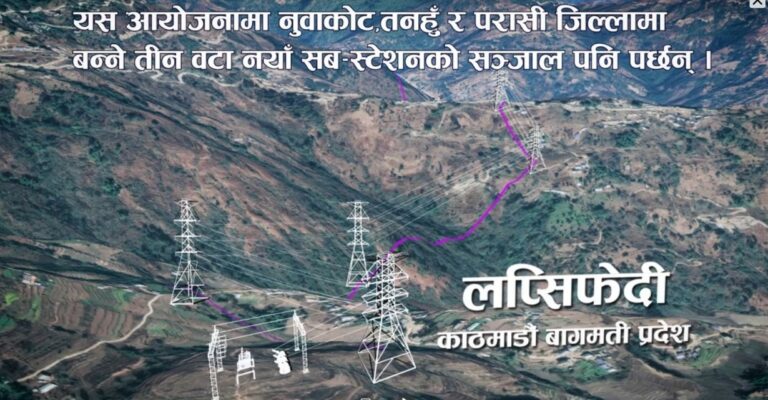
The Ministry of Forests and Environment has approved the Environmental Impact Assessment (EIA) of the transmission line project to be built with the grant of Millennium Challenge Corporation (MCC) agreement.
Besides MCC’s grant, the Government of Nepal will also invest in the project.
According to Khadga Bahadur Bista, Executive Director of Millennium Challenge Account (MCA)-Nepal, the EIA also identifies the current state of the physical, biological, socio-economic and cultural environment of the place where the project will be implemented and suggested measures to be taken to minimize the possible impact.
A statement issued by MCA-Nepal states that to prepare the EIA, interaction and public hearing programs have been conducted in all 30 villages and municipalities of the 10 districts where the project will be implemented on the Lapsiphedi-Galchhi-Damauli-Sunawal power corridor.
Following the EIA’s approval, MCA-Nepal will now proceed with the process of obtaining approval to use the national forest area and remove trees and plants from that area for the transmission line to be built.
PROJECTED DEFORESTATION
According to the EIA, out of the 777.5 hectare forest area to be used by the 313.9 km long 400 kV transmission line and substation project, trees have to be cut down from 354.4 hectare area.
As many as 78,642 trees have to be felled from 330.4 hectare area of 112 community forests, 1,194 trees from 4.4 hectare area of eight confessional forests and 122,182 trees from 442.7 hectare government protected forest.
According to the EIA, 47,908 trees have to be cut down from the forests of Nuwakot; 45,115 from Tanahu; 35,915 from Makwanpur; 29,561 from Dhading and 17,989 from West Nawalparasi.
Similarly, 12,548 trees have to be cut down in Palpa; 6,035 in East Nawarparasi; 3,696 in Sindhupalchowk; 2,173 in Chitwan and 1,378 in Kathmandu.
The EIA mentions that 2,020,180 trees will be planted in affected districts with the coordination of respective district forest offices to compensate for the deforestation.
UNDERSTANDING MCC
The agreement for MCC grant was signed between Nepal government and MCC on September 14, 2017.
After several years of preparation Nepal and MCC signed the Nepal Compact agreement on 14 September 2017. The agreement was signed by the then Minister of Finance Gyanendra Bahadur Karki and MCC’s Acting CEO Jonathan Nash at the U.S. State Department in Washington, D.C.
The two projects – electricity transmission and road maintenance – are priorities identified through extensive consultation with members of Nepali civil society, private sector and numerous other stakeholders.
The United States’ Millennium Challenge Corporation’s Nepal Compact has courted controversy in Nepal as the Pushpa Kamal Dahal-led CPN-Maoist Center strongly opposes MCC’s implementation whereas CPN-UML led by Prime Minister KP Sharma Oli has been lobbying in its favor.
CPN-MC argues that MCC is a part of Washington’s Indo-Pacific Strategy, which has military components aimed at countering China, whereas CPN-UML denies the claim.
Nepal had to qualify and compete with other countries to be eligible and eventually selected for the MCC Compact after successfully meeting MCC’s conditions on good governance, economic freedom, and investing in citizens, and the associated indicators.
The Compact carries a grant of $500 million from US government while Nepal would put in $130 million for the projects to be built under MCC. This is the largest grant Nepal has ever received.
Though Finance Minister Yubaraj Khatiwada registered the compact at the federal parliament for ratification in July 2019, it was never presented before the House for approval.
Though the MCC compact doesn’t say it needs to be ratified by Nepal’s parliament, the text of the agreement says that provisions in the compact will prevail over Nepal’s existing laws in case of conflicts, which requires parliamentary ratification as per the Nepal Treaty Act.





